Canada–We’ve got it all.
Canada is the second-largest country in the world (Russia’s No. 1). Covering most of northern North America, Canada spans 9,984,670 sq km. Canada is a federation of 10 provinces, each with its own administrative system: Alberta, British Columbia, Manitoba, New Brunswick, Newfoundland, Nova Scotia, Ontario, Prince Edward Island, Québec and Saskatchewan. Canada also has three territories: Northwest Territories, the Yukon Territory and Nunavut, its most recent addition.
Alberta
Splendour of the Rockies
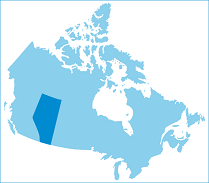 Alberta? Think of the raw and rugged beauty of the Canadian Rockies. But there’s also the prehistoric desert of the Alberta Badlands, where you can unravel the mysteries of the dinosaurs. You can retrace the paths of the Plains Indians on their hunt for buffalo, stopping along the routes of the fur traders, whiskey smugglers and explorers who formed the Canadian version of the Wild West. Cultural life flourishes in resource-rich Alberta. Its contemporary cities are Edmonton (the capital) and sophisticated Calgary. The West Edmonton Mall is the largest of its kind in the world. Calgary is home to the Calgary Stampede, a Wild West festival in July of rodeos, live music, turn-of-the-century exhibitions and an old-fashioned downtown parade. Banff, Jasper and the Lake Louise area offer champagne-powder slopes for arguably the world’s best skiing and most breathtaking scenery.
Alberta? Think of the raw and rugged beauty of the Canadian Rockies. But there’s also the prehistoric desert of the Alberta Badlands, where you can unravel the mysteries of the dinosaurs. You can retrace the paths of the Plains Indians on their hunt for buffalo, stopping along the routes of the fur traders, whiskey smugglers and explorers who formed the Canadian version of the Wild West. Cultural life flourishes in resource-rich Alberta. Its contemporary cities are Edmonton (the capital) and sophisticated Calgary. The West Edmonton Mall is the largest of its kind in the world. Calgary is home to the Calgary Stampede, a Wild West festival in July of rodeos, live music, turn-of-the-century exhibitions and an old-fashioned downtown parade. Banff, Jasper and the Lake Louise area offer champagne-powder slopes for arguably the world’s best skiing and most breathtaking scenery.
British Columbia
Super, Natural
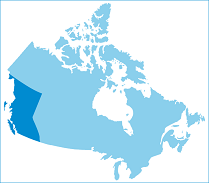 Ski in the morning and golf that same afternoon. This is a province so spectacular and diverse, you can, literally, do it all. It’s a land of clean air, tall trees, craggy mountains, raging whitewater rivers and long, languid beaches. Here you’ll find some of Canada’s freshest and finest coastal seafood. Charter a fishing boat, take a guided whale-watching tour or go zip-trekking in an old-growth tree canopy near Whistler. Aprés outdoor time? Go antique shopping or relax at luxurious spas and natural hot springs. British Columbia’s acclaimed Okanagan Valley is one of Canada’s premium wine-growing regions. Visit a winery, go wine tasting or celebrate at a wine festival. The Okanagan also produces rare icewines. Cosmopolitan flair? Try Vancouver, sexy, glitzy and exotic, and Victoria, charming, gracious and old-world elegant. You’ll find top-rated ethnic cuisines, vibrant arts communities, designer retail boutiques and festive nightlife only add to the natural beauty surrounding these thriving coastal cities.
Ski in the morning and golf that same afternoon. This is a province so spectacular and diverse, you can, literally, do it all. It’s a land of clean air, tall trees, craggy mountains, raging whitewater rivers and long, languid beaches. Here you’ll find some of Canada’s freshest and finest coastal seafood. Charter a fishing boat, take a guided whale-watching tour or go zip-trekking in an old-growth tree canopy near Whistler. Aprés outdoor time? Go antique shopping or relax at luxurious spas and natural hot springs. British Columbia’s acclaimed Okanagan Valley is one of Canada’s premium wine-growing regions. Visit a winery, go wine tasting or celebrate at a wine festival. The Okanagan also produces rare icewines. Cosmopolitan flair? Try Vancouver, sexy, glitzy and exotic, and Victoria, charming, gracious and old-world elegant. You’ll find top-rated ethnic cuisines, vibrant arts communities, designer retail boutiques and festive nightlife only add to the natural beauty surrounding these thriving coastal cities.
Manitoba
The call of the wild
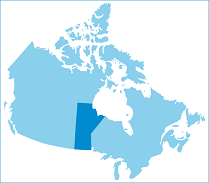 Manitoba skies are bright and sunny year-round. The air is crisp and clear. No wonder this province is home to some of the world’s most wonderful wildlife. Nature enthusiasts flock to the province each year to take in its flora and fauna, most hoping to snap a pic of a polar bear. During the fall in the northern town of Churchill–the “Polar Bear Capital of the World,” hundreds of migrating bears congregate while waiting for sea-ice to form. Birders flock year-round to the Oak Hammock Marsh Interpretive Centre, just 15 minutes from Winnipeg, situated in the midst of one of the best bird-viewing areas on the continent. Aurora Borealis is pure magic. Witness colourful night skies lit up by this luminous phenomenon. In the warmer months, you can swim with the “smiling” beluga whales in Hudson Bay. Winnipeg, the capital city, offers history, arts, culture, family fun and fine dining.
Manitoba skies are bright and sunny year-round. The air is crisp and clear. No wonder this province is home to some of the world’s most wonderful wildlife. Nature enthusiasts flock to the province each year to take in its flora and fauna, most hoping to snap a pic of a polar bear. During the fall in the northern town of Churchill–the “Polar Bear Capital of the World,” hundreds of migrating bears congregate while waiting for sea-ice to form. Birders flock year-round to the Oak Hammock Marsh Interpretive Centre, just 15 minutes from Winnipeg, situated in the midst of one of the best bird-viewing areas on the continent. Aurora Borealis is pure magic. Witness colourful night skies lit up by this luminous phenomenon. In the warmer months, you can swim with the “smiling” beluga whales in Hudson Bay. Winnipeg, the capital city, offers history, arts, culture, family fun and fine dining.
New Brunswick
Marine wonder of Atlantic Canada
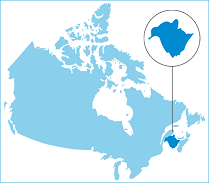 The tides at the Bay of Fundy are the highest on the planet. Hundreds of millions of tons of seawater slosh in and out of the bay twice a day, reportedly equivalent to the flow of all freshwater rivers on earth. Migratory birds by the thousands congregate on the Fundy mudflats to feed on mud shrimp, and there are more species of whales in the bay than anywhere else. New Brunswick is home to the Acadian culture, Canada’s first French settlement with a rich history and culture all its own. Skate on frozen ponds and rinks in winter; visit in spring for maple syrup season and fiddleheads (tender fern tendrils sautéed into a yummy dish). Summer means warm, oceanside walks and sailing with whales alongside. Fall in New Brunswick is brilliant with colour as leaves change in the harvest season.
The tides at the Bay of Fundy are the highest on the planet. Hundreds of millions of tons of seawater slosh in and out of the bay twice a day, reportedly equivalent to the flow of all freshwater rivers on earth. Migratory birds by the thousands congregate on the Fundy mudflats to feed on mud shrimp, and there are more species of whales in the bay than anywhere else. New Brunswick is home to the Acadian culture, Canada’s first French settlement with a rich history and culture all its own. Skate on frozen ponds and rinks in winter; visit in spring for maple syrup season and fiddleheads (tender fern tendrils sautéed into a yummy dish). Summer means warm, oceanside walks and sailing with whales alongside. Fall in New Brunswick is brilliant with colour as leaves change in the harvest season.
Newfoundland and Labrador
Land that lives by the sea
 This extreme landscape of ferocious beauty is made up of glacially carved inland fjords, wild jagged coastlines and towering mountains of ice-crossing paths. Huge 36-ton humpback whales are a common sight. Newfoundland and Labrador are home to an excavated 1,000-year-old Viking settlement, now a UNESCO World Heritage Site. In this rugged land, where numerous generations of people have forged their living from the sea alone, visitors will find some of the most interesting, fun-loving folk in Canada. Newfoundlanders celebrate their heritage with festivals, music and events throughout the summer. Some 200 salmon rivers and thousands of trout streams make Newfoundland the perfect destination for enthusiastic anglers.
This extreme landscape of ferocious beauty is made up of glacially carved inland fjords, wild jagged coastlines and towering mountains of ice-crossing paths. Huge 36-ton humpback whales are a common sight. Newfoundland and Labrador are home to an excavated 1,000-year-old Viking settlement, now a UNESCO World Heritage Site. In this rugged land, where numerous generations of people have forged their living from the sea alone, visitors will find some of the most interesting, fun-loving folk in Canada. Newfoundlanders celebrate their heritage with festivals, music and events throughout the summer. Some 200 salmon rivers and thousands of trout streams make Newfoundland the perfect destination for enthusiastic anglers.
Nova Scotia
Seafaring pride
 Nova Scotia is about sandy ocean shorelines, historic fortresses and the rugged Highlands of Cape Breton. This sprawling province covers 4,600 miles of diverse coastline dotted with lighthouses. Nova Scotia’s bustling urban centre is Halifax; then there’s the rural, in places remote, island-community of Cape Breton Island. Historic Halifax boasts 18th and 19th century architecture alongside a modern downtown business district. Many a famous Canadian fiddler hails from Cape Breton Island, known for its lively music influenced by Scottish jigs and reels. The highway running through the coastal landscape of Cape Breton Highlands National Park is one of North America’s most spectacular scenic drives. Nova Scotia’s been nicknamed “Canada's Festival Province” for good reason: its cities and towns host 600 festivals and events throughout the year.
Nova Scotia is about sandy ocean shorelines, historic fortresses and the rugged Highlands of Cape Breton. This sprawling province covers 4,600 miles of diverse coastline dotted with lighthouses. Nova Scotia’s bustling urban centre is Halifax; then there’s the rural, in places remote, island-community of Cape Breton Island. Historic Halifax boasts 18th and 19th century architecture alongside a modern downtown business district. Many a famous Canadian fiddler hails from Cape Breton Island, known for its lively music influenced by Scottish jigs and reels. The highway running through the coastal landscape of Cape Breton Highlands National Park is one of North America’s most spectacular scenic drives. Nova Scotia’s been nicknamed “Canada's Festival Province” for good reason: its cities and towns host 600 festivals and events throughout the year.
Ontario
Cottage country, waterfalls, urban chic
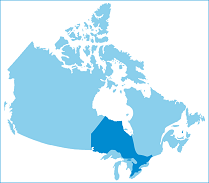 The Native people called Ontario “the land of shining waters,” perhaps inspired by the half-million lakes scattered throughout the land or by breathtaking Niagara Falls, known throughout the world as the “it” spot for honeymooners. Either way, Ontario’s waterways have embellished its image as “cottage country,” where scenic summer getaways are an inherent part of life. People from 70 international cultures make up the province’s population. Their diversity adds culture, arts, cuisine and spark to Ontario’s major cities. Toronto, its capital, is also Canada’s largest city. Toronto has all the metropolitan perks: symphony, ballet, opera, shopping, nightlife and exceptional restaurants. Ottawa is Canada’s political capital and seat of power. Here you can explore the federal Parliament buildings, museums and the superb (oft controversial) art at the National Gallery of Canada. The Niagara region has a thriving theatre and is one of Canada’s foremost wine regions, which is focused mainly on icewine.
The Native people called Ontario “the land of shining waters,” perhaps inspired by the half-million lakes scattered throughout the land or by breathtaking Niagara Falls, known throughout the world as the “it” spot for honeymooners. Either way, Ontario’s waterways have embellished its image as “cottage country,” where scenic summer getaways are an inherent part of life. People from 70 international cultures make up the province’s population. Their diversity adds culture, arts, cuisine and spark to Ontario’s major cities. Toronto, its capital, is also Canada’s largest city. Toronto has all the metropolitan perks: symphony, ballet, opera, shopping, nightlife and exceptional restaurants. Ottawa is Canada’s political capital and seat of power. Here you can explore the federal Parliament buildings, museums and the superb (oft controversial) art at the National Gallery of Canada. The Niagara region has a thriving theatre and is one of Canada’s foremost wine regions, which is focused mainly on icewine.
Prince Edward Island
Lighthouses, lobster, red earth
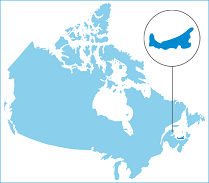 Canada’s island jewel with its red soil and green rolling hills is renowned for sweet lobster, stunning beaches, top-rated golf and Lucy Maud Montgomery’s world-famous novel, Anne of Green Gables. Life here is leisurely, walkable and quaint. Folks are friendly and unassuming. PEI boasts more lighthouses than anywhere else (there are 76), and many visitors like to tour from one to the next by bicycle. An engineering marvel connects Canada’s smallest province to the mainland with the eight-mile Confederation Bridge. So now you can drive to this island retreat, also the birthplace of Canadian Confederation.
Canada’s island jewel with its red soil and green rolling hills is renowned for sweet lobster, stunning beaches, top-rated golf and Lucy Maud Montgomery’s world-famous novel, Anne of Green Gables. Life here is leisurely, walkable and quaint. Folks are friendly and unassuming. PEI boasts more lighthouses than anywhere else (there are 76), and many visitors like to tour from one to the next by bicycle. An engineering marvel connects Canada’s smallest province to the mainland with the eight-mile Confederation Bridge. So now you can drive to this island retreat, also the birthplace of Canadian Confederation.
Québec
French-Canada flair, Old World charm
 Fashion? French? Party all night? Did someone just say, “Québec”? The province is an intriguing mix of wilderness and modern urban life that exudes old world history and European charm. French-flavour city centres Montréal and Québec City are chic and distinct, places where history and architecture mingle with the modern urban world. Both cities bustle with restaurants and bars, nightclubs and theatres, exclusive shopping centres, museums and galleries. The Laurentians, an enchanting mountain and farmland region north of Montréal, is an escape to yesteryear. Think apple orchards, stone farmhouses, artisan cheesemakers and centuries-old timbered homes–although new millennium top-rated resorts and spas, golf and skiing, as well as chateaus and B&Bs abound. The Eastern Townships south of Montréal stretch along the borders of Vermont, New Hampshire and Maine, sharing the quaint aura of New England. Québec also entertains with festivals throughout the year, including the renowned Festival International de Jazz de Montréal and the Just for Laughs Festival, when 2,000 comedians take to the streets.
Fashion? French? Party all night? Did someone just say, “Québec”? The province is an intriguing mix of wilderness and modern urban life that exudes old world history and European charm. French-flavour city centres Montréal and Québec City are chic and distinct, places where history and architecture mingle with the modern urban world. Both cities bustle with restaurants and bars, nightclubs and theatres, exclusive shopping centres, museums and galleries. The Laurentians, an enchanting mountain and farmland region north of Montréal, is an escape to yesteryear. Think apple orchards, stone farmhouses, artisan cheesemakers and centuries-old timbered homes–although new millennium top-rated resorts and spas, golf and skiing, as well as chateaus and B&Bs abound. The Eastern Townships south of Montréal stretch along the borders of Vermont, New Hampshire and Maine, sharing the quaint aura of New England. Québec also entertains with festivals throughout the year, including the renowned Festival International de Jazz de Montréal and the Just for Laughs Festival, when 2,000 comedians take to the streets.
Saskatchewan
Canada’s heartland
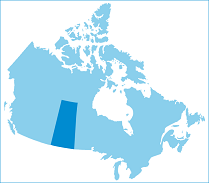 Wide open spaces. Views that go on forever. Golden wheatfields waving in the breeze. The prairie province Saskatchewan stirs the soul with its vast open spaces–and has played muse to many musicians. Saskatchewan’s cosmopolitan capital, Regina (that’s “ruh-JIE-nah,” after Queen Victoria), boasts one of North America's largest urban parks at its core. More than an enchanting green space, Wascana Centre also holds the city’s Royal Saskatchewan Museum, the University of Regina campus, provincial legislative buildings and the finest in regional, national and international art at the MacKenzie Art Gallery. Wascena Centre’s grounds attract visitors who can happily wile away the day (year-round) picnicking, boating, bird watching, cycling and taking nature walks. Saskatoon, the province’s largest city, is considered Canada’s most beautiful mid-sized city thanks to a progressive campaign protecting its riverbanks. The city is also deservedly proud of it vibrant arts theatre and cultural communities.
Wide open spaces. Views that go on forever. Golden wheatfields waving in the breeze. The prairie province Saskatchewan stirs the soul with its vast open spaces–and has played muse to many musicians. Saskatchewan’s cosmopolitan capital, Regina (that’s “ruh-JIE-nah,” after Queen Victoria), boasts one of North America's largest urban parks at its core. More than an enchanting green space, Wascana Centre also holds the city’s Royal Saskatchewan Museum, the University of Regina campus, provincial legislative buildings and the finest in regional, national and international art at the MacKenzie Art Gallery. Wascena Centre’s grounds attract visitors who can happily wile away the day (year-round) picnicking, boating, bird watching, cycling and taking nature walks. Saskatoon, the province’s largest city, is considered Canada’s most beautiful mid-sized city thanks to a progressive campaign protecting its riverbanks. The city is also deservedly proud of it vibrant arts theatre and cultural communities.
Northwest Territories
Midnight sun, Northern Lights
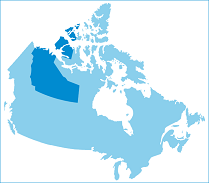 They call it the “land of the midnight sun,” where the Aurora Borealis (Northern Lights) illuminates the sky in eerie, other-worldly dancing lights. An incredibly vast region of wild landscapes, the NWT split into two separate territories in 1999. The eastern lands are now known as Nunavut. The western region, home to Dene, Inuvialuit and other northerners from around the world, is still called the Northwest Territories. During the warm months of summer, visitors can watch the sunset melt into a golden sunrise. The long winter brings with it the Northern Lights, a galaxy of stars. It’s a recipe for staying up all night.
They call it the “land of the midnight sun,” where the Aurora Borealis (Northern Lights) illuminates the sky in eerie, other-worldly dancing lights. An incredibly vast region of wild landscapes, the NWT split into two separate territories in 1999. The eastern lands are now known as Nunavut. The western region, home to Dene, Inuvialuit and other northerners from around the world, is still called the Northwest Territories. During the warm months of summer, visitors can watch the sunset melt into a golden sunrise. The long winter brings with it the Northern Lights, a galaxy of stars. It’s a recipe for staying up all night.
Yukon
Pure wilderness adventure above the 60th parallel
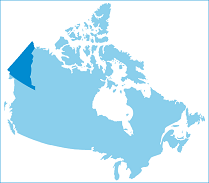 Wild. The Yukon is untamed, and that’s its rugged charm. The Yukon Territory is one of the best places in the world for wilderness adventures. Fishing, hiking, biking, canoeing, rafting, wildlife viewing and enjoying pure nature are a way of life here. The Yukon’s Kluane National Park boasts spectacular scenery and many opportunities to try your hand at heli-hiking or glacier trekking. Whitehorse and Dawson City are the two main city centres and bases for wilderness exploration trips. June through August is prime trip time, but the spring and fall shoulder seasons offer excellent conditions for snow sports and autumn foliage. As chilly as the winter months can be, they offer the best opportunity for catching the brilliant Northern Lights.
Wild. The Yukon is untamed, and that’s its rugged charm. The Yukon Territory is one of the best places in the world for wilderness adventures. Fishing, hiking, biking, canoeing, rafting, wildlife viewing and enjoying pure nature are a way of life here. The Yukon’s Kluane National Park boasts spectacular scenery and many opportunities to try your hand at heli-hiking or glacier trekking. Whitehorse and Dawson City are the two main city centres and bases for wilderness exploration trips. June through August is prime trip time, but the spring and fall shoulder seasons offer excellent conditions for snow sports and autumn foliage. As chilly as the winter months can be, they offer the best opportunity for catching the brilliant Northern Lights.
Nunavut
The land of the Inuit
 As of April 1, 1999, the giant area previously known as the Northwest Territories became two separate territories. The eastern portion is now Nunavut. Nunavut is an Inuktitu word for “our land.” The original people of this land call themselves Inuit, which simply means “the people.” Viewing the stunning Northern Lights, dog sledding and cross-country skiing are ideal winter activities. Community events and gatherings with homespun food, storytelling, dancing and good times with the locals are all part of the warm experience you can expect in Nunavut.
As of April 1, 1999, the giant area previously known as the Northwest Territories became two separate territories. The eastern portion is now Nunavut. Nunavut is an Inuktitu word for “our land.” The original people of this land call themselves Inuit, which simply means “the people.” Viewing the stunning Northern Lights, dog sledding and cross-country skiing are ideal winter activities. Community events and gatherings with homespun food, storytelling, dancing and good times with the locals are all part of the warm experience you can expect in Nunavut.

